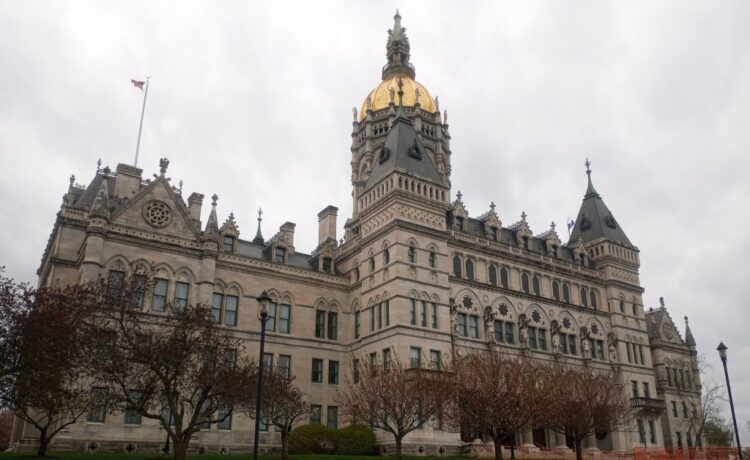The rainy day fund has been one of the prime beneficiaries of Connecticut’s legal budgetary constraints, at one point receiving nearly $3 billion over just three years.
And now that the fiscal guardrails are putting the squeeze on core programs, top legislative leaders say it’s time for the rainy day fund to give something back.
Majority Democrats are exploring shifting annual interest earned by the budget reserve outside of the spending cap, a move that could allow an extra $170 million to protect higher education, social services, early childhood development and health care.
But Gov. Ned Lamont is drawing a line in the sand, saying his fellow Democrats would be violating fiscal principles that helped end a string of deficits and eliminated nearly $8 billion in pension debt.
And that standoff only appears to be intensifying with the legislature’s session’s May 8 adjournment date less than six weeks away.
“If the argument is centered around spending some money earned on interest from the budget reserve fund, that’s a silly argument to have,” House Speaker Matt Ritter, D-Hartford, said Tuesday.
But the Lamont administration sees it differently.
“Any proposal must adhere to all statutory and constitutional caps approved unanimously last year,” said Chris Collibee, the governor’s budget spokesman. “Intercepting this volatile revenue source would violate the spending cap and is thus one the administration could not support.”
The debate is not whether state government has enough funds to support legislators’ spending priorities. The question is: Should Connecticut invest those dollars in programs, or is that too risky? If that’s the case, the state would add those funds to its huge stockpiles of savings.
The preliminary $26 billion budget legislators approved last June for the 2024-25 fiscal year already has a formidable cushion. That plan has a built-in operating surplus of nearly $300 million. It’s already projected to reserve another $450 million through a program that forces the state to save a portion of quarterly income and business tax receipts.
Together those cushions equal 3.3% of the entire General Fund. And that doesn’t include the record-setting $3.3 billion in the rainy day fund.
But that doesn’t mean Democratic legislators can spend any of those excess dollars.
The preliminary 2024-25 budget barely fell under the spending cap that keeps most state expenditure growth in line with household income and inflation. And when the administration revised calculations this past winter, they found the plan now needs $30 million in cuts to stay under the spending cap.
Not only are cuts out of the question, Democrats say, but they must add $300 million to $400 million to the budget — legally — to assist programs some insist are slipping into crisis.
Community college students will pay $5,218 annually next fall, up 11% from two years ago, to attend a higher ed system in deficit and currently working to cut staff. Tuition and fees also are rising at regional state universities and at the University of Connecticut, which also are exploring cutbacks.
Advocates for human service programs — serving persons with disabilities, patients struggling with mental illness and children — say these programs were struggling to meet needs before facing severe financial challenges created by the first few years of the coronavirus pandemic.
Lamont and legislators cushioned that blow in recent years by investing hundreds of millions of dollars in federal pandemic relief. [The spending cap system exempts emergency federal aid.]
But Connecticut has exhausted nearly all the $2.8 billion in funding it received in 2021 through the American Rescue Plan Act.
The administration identified just $55.7 million ARPA funds in early February that were still unspent. Legislators immediately used about $17 million to shore up winter heating assistance programs, leaving about $39 million to help the next budget. The administration is surveying state agencies for any more unspent ARPA dollars.
Democrats also have maneuvered around the cap by carrying hundreds of millions of dollars in operating surplus forward from one fiscal year to the next. Because those carry-forward dollars technically were appropriated in a prior year, they don’t count against future cap calculations when they are spent.
But eroding sales tax receipts and cost overruns in human service agencies have kept this year’s operating surplus modest. Lamont’s budget office pegs it at $109 million, while the legislature’s nonpartisan Office of Fiscal Analysis says it could be just $25.4 million.
It’s possible to legally raise the cap, provided three-fifths of the House and Senate agree. But the governor would first need to declare a budget emergency, something Lamont isn’t expected to do.
So that leaves Democratic legislators well shy of $300 million, having $39 million in federal pandemic aid and anywhere from $25 million to $109 million in operating surplus.
Intercepting revenue: Fiscal flexibility or an accounting gimmick?
That’s when the rainy day fund comes into play.
Democrats don’t want to touch the $3.3 billion in the fund. But what about the annual interest on that money?
It’s hard to calculate the precise amount, since the reserve, along with the rest of the state’s common cash pool, is invested in short-term funds with interest rates that can vary daily. The balance also can shift quickly. When savings exceed statutory limits, funds are drawn from the reserve and used to pay down pension debt.
But according to state Treasurer Erick Russell’s office, the reserve generated roughly $130 million last fiscal year, invested at an average interest rate of 3.93%.
And through the first eight months of this fiscal year, it’s earned an average of 5.38%, generating roughly $118 million. If that performance continues for the remaining four months of this fiscal year, the earnings would top $170 million.
That type of revenue, combined with this year’s operating surplus and available ARPA dollars, might get Democrats close to the funds they want for the next budget.
To move it outside of the cap, legislators could employ an accounting maneuver known as a “revenue intercept.”
Lawmakers would move some program into an off-budget account and assign a revenue stream to fund it. Because those funds would be “intercepted” before they were assigned to the General Fund, they would not count against the cap.
Intercepts have been attacked by critics as little more than fiscal gimmicks that abuse the spending cap system.
But state government has hundreds of funds — albeit many are small — outside of the traditional budget. And both parties have reached for intercepts in the past when in need.
In 2005, a Democrat-controlled legislature directed towns to collect a new $30 municipal land record document fee and send most of the revenue back to a special state account to channel more than $20 million annually into land conservation, historic preservation and affordable housing programs without breaking the spending cap.
Two years later, Gov. M. Jodi Rell, a Republican, wanted to eliminate the municipal tax on motor vehicles — but also to ensure towns wouldn’t lose the revenue. She wanted to “intercept” Connecticut’s share of tribal casino revenues and move it into a special account to fund these payments to keep towns whole. [The legislature rejected the proposal, which also involved increasing municipal education aid and boosting state income tax rates.]
If Democrats were to target rainy day fund interest, there would be some risks.
The $300 surplus built into the preliminary budget for 2024-25 would have to be reduced by whatever amount of interest earnings was “intercepted” and shifted off-budget.
Also, those interest earnings can fluctuate as quickly as do short-term interest rates. Just as the rainy day fund appears poised to generate $170 million in interest this fiscal year and produced $130 million last year, it yielded a tiny fraction of that in the two prior years, even though it still held more than $3 billion available for investment.
In 2021-22, interest rates averaged 0.29% and earnings were roughly $9 million, according to the treasurer’s office. And in 2020-21, the average rate was 0.1% and the return was just $3 million.
Lamont isn’t the only one wary of those risks.
“This is absolutely a gimmick,” said Senate Minority Leader Stephen Harding, R-Brookfield, who called it “contrary to the spirit of what the spending cap is intended for.”
His House counterpart, Vincent J. Candelora of North Branford, also labeled it a gimmick and challenged Democrats to find cost savings and efficiencies rather than simply replacing expiring federal aid with state dollars.
“If we are already looking under the couch cushions to pass a budget, we have problems in the state,” he said, adding that if the economy slips in the next year or two, the extra spending Democrats are seeking will trigger deficits.
But Ritter and Looney countered that the budget has not one safety net but layers upon layers of protection.
They noted that Democrats haven’t proposed tapping the rainy day fund’s principal, but they also aren’t trying to interfere with the program that would save $450 million in volatile revenues next fiscal year.
And under their plan, the General Fund also would still have a built-in operating surplus, albeit less than the $300 million planned now.
With the current budget still operating in the black and the volatility program projected to save almost $480 million this fiscal year, Democrats could invest in core programs and still dedicate hundreds of millions of dollars to bolster reserves and pay down debt.
But Ritter and Senate President Pro Tem Martin M. Looney, D-New Haven, say they won’t ask their respective caucus members to harm core programs when it clearly is unnecessary.
When it comes to state budget constraints, “we certainly want to maintain their spirit, but not to the point we are so locked in by them that we can’t respond to emergency, current needs,” Looney said.
“There are buckets of money that are available,” Ritter said. “If people are reasonable and objective at how they look at this, I don’t anybody’s going to have a huge fight.”
Keith M. Phaneuf is a reporter for The Connecticut Mirror (https://ctmirror.org/ ). Copyright 2024 © The Connecticut Mirror.

















